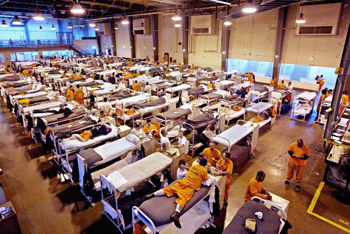California state and local officials, already reeling from budget cuts and public-safety layoffs, are struggling with a federal order to release about 40,000 inmates to reduce prison overcrowding and bracing for the impact on their communities.
State officials have said they will appeal the decision, but as a contingency are cobbling together proposals to comply with the order. At the same time, cash-strapped local governments in places such as Los Angeles and Fresno are grappling with how to monitor and support thousands of released inmates at a time of scaled-down police forces and underfunded social-services programs.

A gymnasium at San Quentin State Prison in California, shown in May, is used to hold inmates' beds. (Associated Press)
This is just awful [since] the court's decision is coming at a time when local public-safety has been slashed drastically," said state Assemblyman Kurt Hagman, a Republican who is a member of the Assembly's Public Safety Committee. He dubbed the order "ludicrous."
The decision Tuesday by a federal judicial panel ordered California to reduce its prison population by more than 40,000 inmates from a total of about 160,000 over the next two years, to relieve overcrowding and improve medical care for inmates. The special three-judge panel gave the state 45 days to develop a plan to carry out the order, which caps the state prison population at 110,000, or 137.5% of capacity. The state's 33 prisons were designed to hold about 85,000 inmates.
California Attorney General Jerry Brown has said he plans to appeal to the U.S. Supreme Court. The order comes just two weeks after Gov. Arnold Schwarzenegger signed a budget deal that includes a $1.2 billion cut to the state prison system.
It is unclear how officials will execute the court's decision. The California Department of Corrections and Rehabilitation said it is working on proposals to reduce the prison population, but those plans need to be approved by the legislature. If the state doesn't comply with the order, it could be held in contempt and fined.
Under the Corrections Department's working plan, however, inmates won't be released en masse. "We aren't opening the floodgates and releasing prisoners," said Matthew Cate, secretary of the department. "We're taking careful, well-thought-out steps to reduce California's inmate population."
The department suggests deporting illegal-immigrant inmates and allowing some low-level offenders to serve the final year of their sentences under house arrest. In addition, the state would reduce sentences of inmates who complete prison rehabilitation programs. The state may also change sentencing guidelines so offenders charged with crimes such as drug possession would be prosecuted for misdemeanors instead of felonies. If convicted, inmates would be sentenced to county jails rather than state prisons.
Assemblyman Danny Gilmore, a Republican, said he expected "very heated arguments over the plan. No one wants to release prisoners, particularly during these difficult times. It's going to be a very interesting debate."
Some local governments say they are unsure how they will support new parolees and an influx to their county jails at a time when their own budgets have been hit by the recession and the state's financial woes.
Steve Whitmore, a spokesman for the Los Angeles County Sheriff's Department, said the prison-reduction proposals are a major concern. The department has cut about $32 million from its budget and faces an additional $25 million of cuts ordered by county supervisors. Mr. Whitmore said that has forced Los Angeles County Sheriff Lee Baca to consider closing a county jail that houses about 1,600 inmates.
A study completed by Los Angeles County in September suggested that 20% of the state's released prisoners would require mental-health treatment and 70% would need alcohol and drug treatment. But with the recession and California's latest budget cuts, "the impact right now would be even worse than it was assumed in September," said Don Knabe, chairman of the Los Angeles County Board of Supervisors.Inmates from Los Angeles County represent about 30% of California's prison population.
Meanwhile, Keith Carson, a supervisor in Alameda County, which includes Oakland, said budget cuts have resulted in fewer programs to help offenders re-enter the community. The county recently closed a $178 million budget gap with program cuts and layoffs, including eliminating about 100 positions in its sheriff's office and 14 public defenders.
"The inmates will be released into an environment that doesn't have the ability to accommodate them," Mr. Carson said. "It's going to be easier for them to revert back to their old habits."
The court order was sparked by a class-action lawsuit filed on behalf of inmates in 2001 by the Prison Law Office, a San Francisco-based inmate advocacy group, which brought attention to understaffed prison hospitals and inadequately trained caregivers.











